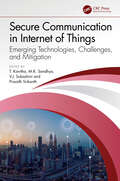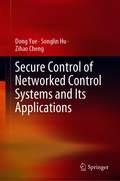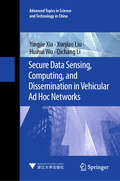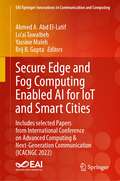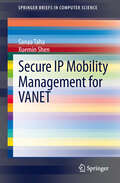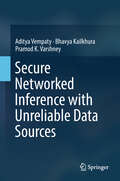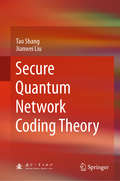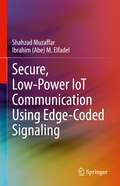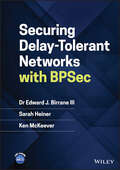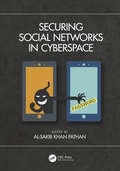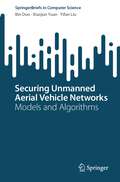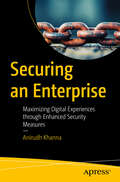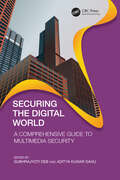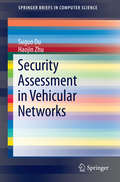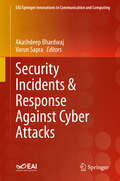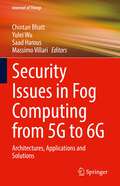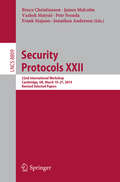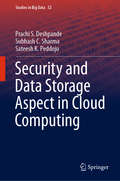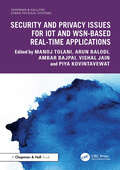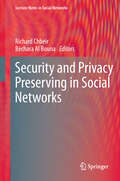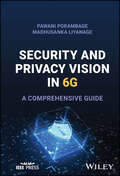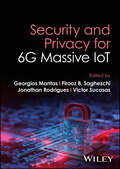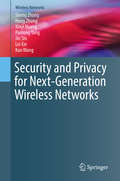- Table View
- List View
Secure Communication in Internet of Things: Emerging Technologies, Challenges, and Mitigation
by T. Kavitha Prasidh Srikanth M. K. Sandhya V. J. SubashiniThe book Secure Communication in Internet of Things: Emerging Technologies, Challenges, and Mitigation will be of value to the readers in understanding the key theories, standards, various protocols, and techniques for the security of Internet of Things hardware, software, and data, and explains how to design a secure Internet of Things system. It presents the regulations, global standards, and standardization activities with an emphasis on ethics, legal, and social considerations about Internet of Things security. Features:● Explores the new Internet of Things security challenges, threats, and future regulations to end-users.● Presents authentication, authorization, and anonymization techniques in the Internet of Things.● Illustrates security management through emerging technologies such as blockchain and artificial intelligence.● Highlights the theoretical and architectural aspects, foundations of security, and privacy of the Internet of Things framework.● Discusses artificial-intelligence-based security techniques, and cloud security for the Internet of Things.It will be a valuable resource for senior undergraduates, graduate students, and academic researchers in fields such as electrical engineering, electronics and communications engineering, computer engineering, and information technology.
Secure Control of Networked Control Systems and Its Applications
by Dong Yue Songlin Hu Zihao ChengThis book shows some secure control methods of networked control systems related to linear control system, nonlinear control system, multi-agent system and its applications in power systems. The proposed secure control methods provide some useful results about modeling of network attacks, resilient analysis and synthesis methods, active defense control method.The contents of this book are lists as followings. (1) Modeling of DoS attacks, deception attacks and replay attacks; (2)Secure control methods are proposed by combing delay system method, switched system method and event-based control method. (3) Active control methods are proposed by using model-predictive control and redundant control. (4) The proposed control methods are applied to the security problem of power system.The methods of this book include DoS attacks modeling such as, periodic jamming attack model,model-based average dwell time model, deception attack modeling and relay attack modeling; piece-wise Lyapunov-Krasoviskiifunctional method, stochastic control method; the results including resilient conditions of networked control system and related resilient control design method with linear matrix inequalities(LMIs).From this book, readers can learn about the general network attack modeling methods, resilient analysis and synthesis methods, active control methods from viewpoint of redundancy control, and secure conditions of power systems.Some fundamental knowledge prepared to read this book includes delay system theory, event triggered mechanism, T-S fuzzy system theory and frequency/voltage control of power system.
Secure Data Sensing, Computing, and Dissemination in Vehicular Ad Hoc Networks (Advanced Topics in Science and Technology in China #1)
by Yingjie Xia Xuejiao Liu Huihui Wu Qichang LiThis book focuses on the fields of security of vehicular ad hoc networks (VANETs). Building upon previous research findings, it conducts research on three modules: secure data sensing, computing, and dissemination in VANETs. The book adopts a combination of security analysis, theoretical analysis, and simulation analysis to comprehensively evaluate and demonstrate the effectiveness and performance of proposed solutions. It aims to assist other researchers in conducting studies on the data security issues of vehicular ad hoc networks, while designing secure and efficient schemes.
Secure Edge and Fog Computing Enabled AI for IoT and Smart Cities: Includes selected Papers from International Conference on Advanced Computing & Next-Generation Communication (ICACNGC 2022) (EAI/Springer Innovations in Communication and Computing)
by Brij B. Gupta Yassine Maleh Lo’ai Tawalbeh Ahmed A. Abd El-LatifThis book gathers recent research in security and privacy to discuss, evaluate, and improve the novel approaches of data protection in IoT and edge and fog computing. The primary focus of the book addresses security mechanisms in IoT and edge/ fog computing, advanced secure deployments for large scaled edge/ fog computing, and new efficient data security strategy of IoT and edge/ fog computing. The book lays a foundation of the core concepts and principles of IoT and 5G security, walking the reader through the fundamental ideas. This book is aimed at researchers, graduate students, and engineers in the fields of secure IoT and edge/ fog computing. The book also presents selected papers from International Conference on Advanced Computing & Next-Generation Communication (ICACNGC 2022).
Secure Fusion Estimation and Control for Cyber-Physical Systems Under Malicious Attacks
by Wen-An Zhang Bo Chen Li Yu Tongxiang LiThe book focuses on the issues of secure fusion estimation and control in cyber-physical systems under cyber-attacks, such as privacy protection under eavesdropping attacks, security fusion estimation under DoS and FDI attacks, and model-based and model-free security control under cyber-attacks. The comprehensive and systematic treatment of security protection in cyber-physical systems is one of the main features of the book, which is particularly suitable for readers interested in learning practical solutions for the security of cyber-physical systems. The book can benefit researchers, engineers and graduate students in the fields of control science and engineering, computer science, communication engineering, etc.
Secure IP Mobility Management for VANET
by Xuemin Shen Sanaa TahaThis brief presents the challenges and solutions for VANETs' security and privacy problems occurring in mobility management protocols including Mobile IPv6 (MIPv6), Proxy MIPv6 (PMIPv6), and Network Mobility (NEMO). The authors give an overview of the concept of the vehicular IP-address configurations as the prerequisite step to achieve mobility management for VANETs, and review the current security and privacy schemes applied in the three mobility management protocols. Throughout the brief, the authors propose new schemes and protocols to increase the security of IP addresses within VANETs including an anonymous and location privacy-preserving scheme for the MIPv6 protocol, a mutual authentication scheme that thwarts authentication attacks, and a fake point-cluster based scheme to prevent attackers from localizing users inside NEMO-based VANET hotspots. The brief concludes with future research directions. Professionals and researchers will find the analysis and new privacy schemes outlined in this brief a valuable addition to the literature on VANET management.
Secure Networked Inference with Unreliable Data Sources
by Aditya Vempaty Bhavya Kailkhura Pramod K. VarshneyThe book presents theory and algorithms for secure networked inference in the presence of Byzantines. It derives fundamental limits of networked inference in the presence of Byzantine data and designs robust strategies to ensure reliable performance for several practical network architectures. In particular, it addresses inference (or learning) processes such as detection, estimation or classification, and parallel, hierarchical, and fully decentralized (peer-to-peer) system architectures. Furthermore, it discusses a number of new directions and heuristics to tackle the problem of design complexity in these practical network architectures for inference.
Secure Quantum Network Coding Theory
by Tao Shang Jianwei LiuThis is the first book on secure quantum network coding, which integrates quantum cryptography into quantum communication. It summarizes the main research findings on quantum network coding, while also systematically introducing readers to secure quantum network coding schemes. With regard to coding methods, coding models and coding security, the book subsequently provides a series of quantum network coding schemes based on the integration of quantum cryptography into quantum communication. Furthermore, it describes the general security analysis method for quantum cryptographic protocols. Accordingly, the book equips readers with effective tools for researching and applying quantum network coding.
Secure, Low-Power IoT Communication Using Edge-Coded Signaling
by Ibrahim (Abe) Elfadel Shahzad MuzaffarThis book discusses single-channel, device-to-device communication in the Internet of Things (IoT) at the signal encoding level and introduces a new family of encoding techniques that result in significant simplifications of the communication circuitry. These simplifications translate into lower power consumption, smaller form factors, and dynamic data rates that are tolerant to clock discrepancies between transmitter and receiver. Readers will be introduced to signal encoding that uses edge-coded signaling, based on the coding of binary data as counts of transmitted pulses. The authors fully explore the far-reaching implications of these novel signal-encoding techniques and illustrate how their usage can help minimize the need for complex circuitries for either clock and data recovery or duty-cycle correction. They also provide a detailed description of a complete ecosystem of hardware and firmware built around edge-code signaling. The ecosystem comprises an application-specific processor, automatic protocol configuration, power and data rate management, cryptographic primitives, and automatic failure recovery modes. The innovative IoT communication link and its associated ecosystem are fully in line with the standard IoT requirements on power, footprint, security, robustness, and reliability.
Securing Delay-Tolerant Networks with BPSec
by Edward J. Birrane III Sarah Heiner Ken McKeeverSecuring Delay-Tolerant Networks with BPSec One-stop reference on how to secure a Delay-Tolerant Network (DTN), written by experienced industry insiders Securing Delay-Tolerant Networks with BPSec answers the question, “How can delay-tolerant networks be secured when operating in environments that would otherwise break many of the common security approaches used on the terrestrial Internet today?” The text is composed of three sections: (1) security considerations for delay-tolerant networks, (2) the design, implementation, and customization of the BPSec protocol, and (3) how this protocol can be applied, combined with other security protocols, and deployed in emerging network environments. The text includes pragmatic considerations for deploying BPSec in both regular and delay-tolerant networks. It also features a tutorial on how to achieve several important security outcomes with a combination of security protocols, BPSec included. Overall, it covers best practices for common security functions, clearly showing designers how to prevent network architecture from being over-constrained by traditional security approaches. Written by the lead author and originator of the BPSec protocol specification, Securing Delay-Tolerant Networks (DTNs) with BPSec includes information on: The gap between cryptography and network security, how security requirements constrain network architectures, and why we need something different DTN stressing conditions, covering intermittent connectivity, congested paths, partitioned topologies, limited link state, and multiple administrative controls Securing the terrestrial internet, involving a layered approach to security, the impact of protocol design on security services, and securing the internetworking and transport layers A delay-tolerant security architecture, including desirable properties of a DTN secure protocol, fine-grained security services, and protocol augmentation Securing Delay-Tolerant Networks (DTNs) with BPSec is a one-stop reference on the subject for any professional operationally deploying BP who must use BPSec for its security, including software technical leads, software developers, space flight mission leaders, network operators, and technology and product development leaders in general.
Securing Electricity Supply in the Cyber Age: Exploring the Risks of Information and Communication Technology in Tomorrow's Electricity Infrastructure
by Margot P. Weijnen Zofia Lukszo Geert DeconinckThe electricity infrastructure is one of society's most critical infrastructures. The complexity of the electricity infrastructure system is increasing quickly, due to the increasing intensity of market-based power exchanges between electricity systems, the associated market restructuring and an increasing share of decentralized generation. As a consequence, the organizational complexity of power systems has exploded. At the same time, there is a shift in public and societal goals towards low-carbon and sustainable power generation. This will eventually require a drastic transformation of the industry. Increasingly, ICT is being depended upon for managing this infrastructure, for technical control and operation and for facilitating markets. A recent example is demand-side management, based on detailed metering of consumption and decentralized electricity generation. The mutual dependence of the electricity and the ICT infrastructures raises challenging questions in the areas of dependability, security and resilience. Examples include vulnerability to (cyber) attacks, avoiding and repairing technical failures and protecting data confidentiality, while guaranteeing accessibility. Therefore, better models and methods for protection against exploits of system vulnerabilities, whether accidental or intentional such as in cyber attacks, are called for. To address the above mentioned problems an advanced research workshop: "Electricity security in the cyber age: Managing the increasing dependence of the electricity infrastructure on ICT" was organized in the Netherlands in May 2009. The objective of the workshop was to contribute to the security of current and future electricity infrastructures by analyzing the risks that are caused by the increasing reliance upon ICT and investigating options for managing these risks. The book presents the contributions to the workshop by distinguished invited keynote speakers and participants from the international scientific and industrial community.
Securing Social Networks in Cyberspace
by Al-Sakib Khan PathanThis book collates the key security and privacy concerns faced by individuals and organizations who use various social networking sites. This includes activities such as connecting with friends, colleagues, and family; sharing and posting information; managing audio, video, and photos; and all other aspects of using social media sites both professionally and personally. In the setting of the Internet of Things (IoT) that can connect millions of devices at any one time, the security of such actions is paramount. Securing Social Networks in Cyberspace discusses user privacy and trust, location privacy, protecting children, managing multimedia content, cyberbullying, and much more. Current state-of-the-art defense mechanisms that can bring long-term solutions to tackling these threats are considered in the book. This book can be used as a reference for an easy understanding of complex cybersecurity issues in social networking platforms and services. It is beneficial for academicians and graduate-level researchers. General readers may find it beneficial in protecting their social-media-related profiles.
Securing Unmanned Aerial Vehicle Networks: Models and Algorithms (SpringerBriefs in Computer Science)
by Xiaojun Yuan Bin Duo Yifan LiuThis book focuses on the model and algorithm aspects of securing Unmanned Aerial Vehicle Networks (UAV). To equip readers with the essential knowledge required for conducting research in this field, it covers the foundational concepts of this topic as well. This book also offers a detailed insight into UAV networks from the physical layer security point of view.The authors discuss the appropriate channel models for characterizing various propagation environments that UAV networks are exposed. The state-of-the-art technologies, such as UAV trajectory design, cooperative jamming and reconfigurable intelligent surfaces are covered. The corresponding algorithms for significantly improving the security of UAV networks, along with practical case studies on topics such as energy-efficient and secure UAV networks, elevation angle-distance trade-off for securing UAV networks and securing UAV networks with the aid of reconfigurable intelligent surfaces are presented as well. Last, this book outlines the future challenges and research directions to facilitate further studies on secure UAV networks. This book is suitable reading for graduate students and researchers who are interested in the research areas of UAV networking and communications, IoT security, and physical layer security in wireless networks. Professionals working within these related fields will also benefit from this book.
Securing an Enterprise: Maximizing Digital Experiences through Enhanced Security Measures
by Anirudh KhannaDive into the world of digital security and navigate its intricate landscape. In an era where digital reliance is ubiquitous, the need for robust cybersecurity measures has never been more pressing. Part of author Saurav Bhattacharya’s trilogy that covers the essential pillars of digital ecosystems—security, reliability, and usability—this book sheds light on the dynamic challenges posed by cyber threats, advocating for innovative security solutions that safeguard users while upholding their digital freedoms. Against the backdrop of rapid technological advancement and escalating cyber threats, this book addresses pressing security concerns at the forefront of our digital era. You’ll learn that trust plays a pivotal role in fostering a secure digital environment, enabling individuals and organizations to flourish without fear of malicious exploits. With transformative technologies like AI, blockchain, and quantum computing on the horizon, understanding and addressing cybersecurity fundamentals is essential for traversing the evolving digital landscape. Securing an Enterprise is your roadmap towards a future where technology aligns with humanity, fostering a more equitable, secure, and interconnected world. What You will Learn Explore advanced methodologies and innovative approaches to bolster cybersecurity Understand the potential impacts of the advancements on security Provide strategic guidance on adapting to security changes to ensure sustainability Take a holistic approach in reviewing security Who This Book Is For Cybersecurity Professionals, Technology Developers and Engineers
Securing the Digital World: A Comprehensive Guide to Multimedia Security
by Aditya Kumar Sahu Subhrajyoti DebSecuring the Digital World: A Comprehensive Guide to Multimedia Security is indispensable reading in today's digital age. With the outbreak of digital range and ever-evolving cyber threats, the demand to protect multimedia data has never been more imperative. This book provides comprehensive research on multimedia information security and bridges the gap between theoretical bases and practical applications.Authored by leading experts in the area, the book focusses on cryptography, watermarking, steganography and its advanced security solution while keeping a clear and engaging description and sets this book apart in its capability to make complex concepts accessible and practical, making it an incalculable resource for beginners and seasoned professionals alike.Key Features: Detailed study of encryption techniques, including encryption and decryption methods adapted to multimedia data A comprehensive discussion of techniques for embedding and detecting hidden information in digital media A survey of the latest advances in multimedia security, including quantum cryptography and blockchain applications Real-world case studies and illustrations that demonstrate the application of multimedia information security techniques in various initiatives Contributions from computer science and information technology experts offer a comprehensive perspective on multimedia security This book is an invaluable help for cybersecurity professionals, IT professionals, and computer and information technology students. Securing the Digital World equips readers with the information and tools required to safeguard multimedia content in a cyber-spatiality full of security challenges.
Security Assessment in Vehicular Networks
by Suguo Du Haojin ZhuThis book presents several novel approaches to model the interaction between the attacker and the defender and assess the security of Vehicular Ad Hoc Networks (VANETs). The first security assessment approach is based on the attack tree security assessment model, which leverages tree based methods to analyze the risk of the system and identify the possible attacking strategies the adversaries may launch. To further capture the interaction between the attacker and the defender, the authors propose to utilize the attack-defense tree model to express the potential countermeasures which could mitigate the system. By considering rational participants that aim to maximize their payoff function, the brief describes a game-theoretic analysis approach to investigate the possible strategies that the security administrator and the attacker could adopt. A phased attack-defense game allows the reader to model the interactions between the attacker and defender for VANET security assessment. The brief offers a variety of methods for assessing the security of wireless networks. Professionals and researchers working on the defense of VANETs will find this material valuable.
Security Incidents & Response Against Cyber Attacks (EAI/Springer Innovations in Communication and Computing)
by Akashdeep Bhardwaj Varun SapraThis book provides use case scenarios of machine learning, artificial intelligence, and real-time domains to supplement cyber security operations and proactively predict attacks and preempt cyber incidents. The authors discuss cybersecurity incident planning, starting from a draft response plan, to assigning responsibilities, to use of external experts, to equipping organization teams to address incidents, to preparing communication strategy and cyber insurance. They also discuss classifications and methods to detect cybersecurity incidents, how to organize the incident response team, how to conduct situational awareness, how to contain and eradicate incidents, and how to cleanup and recover. The book shares real-world experiences and knowledge from authors from academia and industry.
Security Issues in Fog Computing from 5G to 6G: Architectures, Applications and Solutions (Internet of Things)
by Chintan Bhatt Yulei Wu Massimo Villari Saad HarousThe book provides an examination of how fog security is changing the information technology industry and will continue to in the next decade. The authors first discuss how fog enables key applications in wireless 5G, the Internet of Things, and big data. The book then presents an overview of fog/edge computing, focusing on its relationship with cloud technology, Internet of Things and the future with the use of secure 5G/6G communication. The book also presents a comprehensive overview of liabilities in fog/edge computing within multi-level architectures and the intelligent management. The last part of the book reviews applications of fog/edge computing in smart cities, including in Industrial IoT, edge-based augmented reality, data streaming, and blockchain-based.
Security Protocols XXIII
by Jonathan Anderson Bruce Christianson Petr Švenda Vashek Matyáš James Malcolm Frank StajanoThis book constitutes the thoroughly refereed post-workshop proceedings of the 23rd International Workshop on Security Protocols, held in Cambridge, UK, in March/April 2015. After an introduction the volume presents 18 revised papers each followed by a revised transcript of the presentation and ensuing discussion at the event. The theme of this year's workshop is "Information Security in Fiction and in Fact".
Security and Data Storage Aspect in Cloud Computing (Studies in Big Data #52)
by Prachi S. Deshpande Subhash C. Sharma Sateesh K. PeddojuThis book analyses the various security threats in cloud computing. A host-based IDS (HIDS) using signature verification is developed and implemented for the concerned security issues. Further, owing to the vulnerability of distributed denial of service (DDoS) attacks in cloud computing, a network based IDS (NIDS) is developed and implemented against such attacks. The performance of these IDS is verified in the Cloud scenario as well against the standard data set. Finally, a simple data storage and security model is developed and implemented for the Cloud computing scenario. The contents of this book will be of interest to researchers and professionals alike.
Security and Privacy Issues for IoT and WSN-based Real-time Applications (Chapman & Hall/CRC Cyber-Physical Systems)
by Vishal Jain Ambar Bajpai Arun Balodi Manoj TolaniThis book explores the security and privacy challenges associated with real-time applications of the Internet of Things (IoT) and wireless sensor networks (WSN) technologies. It provides detailed insights into the unique security and privacy concerns, such as malicious attacks, data breaches, insider threats, and privacy breaches, that arise in the context of real-time applications, like in smart homes, smart cities, industrial automation, healthcare, and other time-sensitive domains to offer practical solutions and strategies to mitigate these risks. Covers various aspects of security and privacy, including authentication, access control, data integrity, confidentiality, availability, threat detection and mitigation, privacy-preserving techniques Investigates the possibilities of cross-layer approaches to address the specific requirements of real-time applications and develop innovative solutions Gaining insights into fundamental limits through information-theoretic research, new protocol designs are developed to access the medium in an energy-efficient manner to improve the performance and reliability of WSN and IoT networks for real-time applications Discusses the sustainable requirements of emerging real-time applications, such as low energy consumption and high data rates Offers an interdisciplinary approach that encompasses areas of communication, networking, and information theory to guide real-life deployment of IoT/ WSN-based monitoring systems It is a valuable reference for readers who want to gain a deeper understanding of the challenges and solutions related to the security and privacy of IoT and WSN in the context of real-time applications.
Security and Privacy Preserving in Social Networks
by Richard Chbeir Bechara Al BounaThis volume aims at assessing the current approaches and technologies, as well as to outline the major challenges and future perspectives related to the security and privacy protection of social networks. It provides the reader with an overview of the state-of-the art techniques, studies, and approaches as well as outlining future directions in this field. A wide range of interdisciplinary contributions from various research groups ensures for a balanced and complete perspective.
Security and Privacy Vision in 6G: A Comprehensive Guide
by Madhusanka Liyanage Pawani PorambageSECURITY AND PRIVACY VISION IN 6G Prepare for the future of mobile communication with this comprehensive study 6G is the next frontier in mobile communication, with development of 6G standards slated to begin as early as 2026. As telecommunications networks become faster and more intelligent, security and privacy concerns are critical. In an increasingly connected world, there is an urgent need for user data to be safeguarded and system security enhanced against a new generation of threats. Security and Privacy Vision in 6G provides a comprehensive survey of these threats and the emerging techniques for safeguarding against them. It includes mechanisms for prediction, detection, mitigation, and prevention, such that threats to privacy and security can be forestalled at any stage. Fully engaged with proposed 6G architectures, it is an essential resource for mobile communications professionals looking for a head start on the technology of the future. Security and Privacy Vision in 6G readers will also find: Detailed coverage of topics including edge intelligence and cloudification, industrial automation, collaborative robots, and more Treatment balancing the practical and the theoretical An editorial team with decades of international network technology experience in both industry and academia Security and Privacy Vision in 6G is a vital reference for network security professionals and for postgraduate and advanced undergraduate students in mobile communications and network security-related fields.
Security and Privacy for 6G Massive IoT
by Jonathan Rodriguez Victor Sucasas Georgios Mantas Firooz B. SaghezchiAnticipate the security and privacy threats of the future with this groundbreaking text The development of the next generation of mobile networks (6G), which is expected to be widely deployed by 2030, promises to revolutionize the Internet of Things (IoT), interconnecting a massive number of IoT devices (massive IoT) on a scale never before envisioned. These devices will enable the operation of a wide spectrum of massive IoT applications such as immersive smart cities, autonomous supply chain, flexible manufacturing and more. However, the vast number of interconnected IoT devices in the emerging massive IoT applications will make them vulnerable to an unprecedented variety of security and privacy threats, which must be anticipated in order to harness the transformative potential of these technologies. Security and Privacy for 6G Massive IoT addresses this new and expanding threat landscape and the challenges it poses for network security companies and professionals. It offers a unique and comprehensive understanding of these threats, their likely manifestations, and the solutions available to counter them. The result creates a foundation for future efforts to research and develop further solutions based on essential 6G technologies. Readers will also find: Analysis based on the four-tier network architecture of 6G, enhanced by Edge Computing and Edge Intelligence Detailed coverage of 6G enabling technologies including blockchain, distributed machine learning, and many more Scenarios, use cases, and security and privacy requirements for 6G Massive IoT applications Security and Privacy for 6G Massive IoT is ideal for research engineers working in the area of IoT security and designers working on new 6G security products, among many others.
Security and Privacy for Next-Generation Wireless Networks (Wireless Networks)
by Lei Xie Xinyi Huang Sheng Zhong Kun Wang Hong Zhong Panlong Yang Jin ShiThis timely book provides broad coverage of security and privacy issues in the macro and micro perspective. In macroperspective, the system and algorithm fundamentals of next-generation wireless networks are discussed. In micro-perspective, this book focuses on the key secure and privacy techniques in different emerging networks from the interconnection view of human and cyber-physical world. This book includes 7 chapters from prominent international researchers working in this subject area. This book serves as a useful reference for researchers, graduate students, and practitioners seeking solutions to wireless security and privacy related issues Recent advances in wireless communication technologies have enabled the large-scale deployment of next-generation wireless networks, and many other wireless applications are emerging. The next generation of mobile networks continues to transform the way people communicate and access information. As a matter of fact, next-generation emerging networks are exploiting their numerous applications in both military and civil fields. For most applications, it is important to guarantee high security of the deployed network in order to defend against attacks from adversaries, as well as the privacy intrusion. The key target in the development of next-generation wireless networks is to promote the integration of the human, cyber, and physical worlds. Previous work in Cyber Physical Systems (CPS) considered the connection between the cyber world and the physical world. In the recent studies, human involvement brings new channels and initiatives in this interconnection. In this integration process, security and privacy are critical issues to many wireless network applications, and it is a paramount concern for the growth of next-generation wireless networks. This is due to the open nature of wireless communication and the involvement of humans. New opportunities for tackling these security and privacy issues in next-generation wireless networks will be achieved by leveraging the properties of interaction among human, computers and things.
